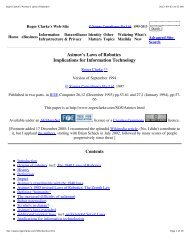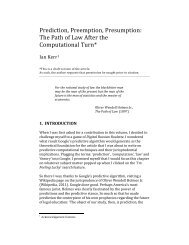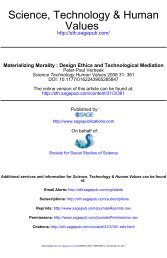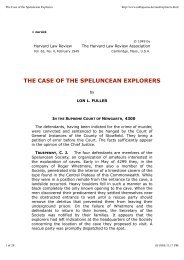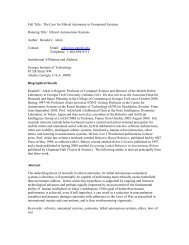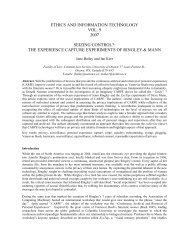Plain Language: beyond a 'movement' Repositioning clear ...
Plain Language: beyond a 'movement' Repositioning clear ...
Plain Language: beyond a 'movement' Repositioning clear ...
- No tags were found...
Create successful ePaper yourself
Turn your PDF publications into a flip-book with our unique Google optimized e-Paper software.
<strong>Plain</strong> <strong>Language</strong>: <strong>beyond</strong> a ‘movement'<strong>Repositioning</strong> <strong>clear</strong> communication in the minds of decision-makersChristopher Balmford, Director, Cleardocs Pty LtdTable of contents1. Introduction2. CUT3. The success of plain language4. Is there a problem referring to the "plain-language movement"?5. Rebutting the misconceptions about a "movement"5.1 A Canadian financial services organization5.2 The international accountancy firm KPMG5.3 CUT5.4 CUT5.5 CUT5.6 What next for plain language?6. Establishing some threshold realities6.1 Beyond mere word substitution6.2 <strong>Plain</strong>-language improves accuracy, certainty, and precision6.3 CUT7. If plain language is "<strong>beyond</strong> a movement", what is it?7.1 The burden7.2 The opportunities and promise8. A possible new position for plain language8.1 Voice8.2 Brand8.3 Voice of the brand8.4 CUT9. CUT9.1 CUT9.2 CUT10. CUT1. IntroductionFor hundreds of years, people have bemoaned the unintelligibility of legal documents and campaignedto make them <strong>clear</strong>er. Increasingly, that activity has been described as a movement—the "plainlanguagemovement" (2).1
Yet talking about plain language as a "movement" (in the sense of a quasi-political, society-changingcause) seems odd and out of date given that:many of the people championing the cause make their living from their plain languageactivities (which is fine—but sometimes creates a mild conflict of interest); andmany commercial organizations use plain language as a distinguishing feature, or provideplain language related services (even though most of those organizations aren't remotelyinterested in championing the plain language cause).In this article, I review the state of play on the plain language front and attempt to show that plainlanguage is a movement no longer. Instead, it has evolved to become a product, a business, anindustry, or a professional service. Then I move onto consider how the evolution of plain languageaffects law firms, their clients, and the State's relationship with its citizens.Then I suggest that to further build on the success of plain language, we need to help key decisionmakersin business and government to see plain language in a new light.Although my plain language experience has largely been with legal and related documents, thethemes in this paper apply equally to all documents used in business, in government, and forconsumers.3. The success of plain languageInitially, the plain-language movement focussed on the social benefits of <strong>clear</strong> legal communication:improving access to justice, and enabling consumers to make more informed decisions. (6)In more recent times, plain language proponents moved on to focus on the benefits that plainlanguage can deliver to the people whom the movement was seeking to convert—key decision-makersin business and in government. On the whole, those key decision-makers are more interested in theeconomic benefits of plain language: improvements in efficiency, effectiveness, and customersatisfaction. (7)Yet even after this change in focus, many decision-makers outside the legal profession still seem tosee plain language as merely a worthy off-shoot of the consumer movement.Where the plain-language movement has really succeeded is in its debate with the legal professionabout whether plain language is accurate, certain, and precise. <strong>Plain</strong> language won that debate. This isshown by the fact that in most English speaking countries, the legal profession no longer argues that itis impossible for a document to be:on the one hand, <strong>clear</strong> and reader-friendly; andon the other hand, accurate, certain, and precise.It is this success of the plain-language movement that has enabled people to earn a living—andmore—through plain language. And that has created the situation in which it is a little odd to go oncalling the plain language thing a "movement."4. Is there a problem referring to the "plain language movement"?It seems to me that continuing to refer to the "plain language movement" raises 2 problems.First, as I mentioned earlier, there is a minor conflict of interest. <strong>Plain</strong>-language practitionerscan end up sending a mixed message, something like: "Join the cause and … umm… err… usemy services". One day, that conflict may turn out to hurt the cause.Second, and more importantly, I fear that the misconception that plain language is amovement impedes the acceptance, adoption, and implementation of plain language. Let me2
e frank about this, I think this is a problem for the plain-language movement and for readersand organizations everywhere—and … umm… err... a problem for my business too. (There'sthe mixed message again.)People outside the plain language world who see plain language as a movement usually have a closelyrelated misconception, namely, that plain language is relevant only when writing to "retailconsumers"—to the proverbial "mums and dads".That misconception further impedes progress. For example, plain language—whether we see it as amovement or an industry—had a major win in 1998, when the United States Securities ExchangeCommission implemented regulations that required certain parts of prospectuses aimed at retailinvestors to be in plain language. (8)A few months later I worked on an international prospectus for one of Australia's 10 largestcompanies. A team of US lawyers from one of the most prominent New York law firms worked on thedocuments. They told me about a US prospectus they had worked on a few months earlier in whichshares were to be offered to retail investors. So they had prepared the relevant parts of theprospectus in plain language to comply with the new SEC requirements.Then after the prospectus was more or less complete, their client company changed its mind anddecided that the shares would be offered only to institutional investors. So the lawyers rewrote theplain language document back into legalese. The mind boggles.5. Rebutting the misconceptions about a "movement"So plain language progress is impeded by two closely related misconceptions:misconception 1, plain language is a movement; andmisconception 2, because plain language is a movement, it is relevant only for retailconsumers.That these 2 views are misconceptions is made <strong>clear</strong> when one considers what's happening on theplain language front in business.Let's consider:the Canadian financial services organization Clarica;the international accountancy firm KPMG; andtwo major Australian law firms that provide plain language services and that promote theclarity of their advice, and the plainness of the documents they write, as a distinguishingfeature of the firm—a feature that adds value for clients.While we're at it, let's review some plain language developments around the world.5.1 A Canadian financial services organizationIn 1999, the Canadian financial services organization The Mutual Group demutualised, listed, andrebranded. As part of that rebranding, the company renamed itself "Clarica" and adopted the brandpromise "Clarity through dialogue".Clarica is a play on words for "clarity". The company's television ads show the Word "clarity" first, andthen the last 2 letters "ty" rotate to become "ca" to make "Clarica". The company wants people tomake the connection between <strong>clear</strong> communication and the company. As the Clarica website reports:Clarica was Mutual Life of Canada. With its conversion to a shareholder company, the century oldname was no longer appropriate. The new name was carefully chosen to portray the strength of thecompany as it heads into a new age. Clarica captures the power of <strong>clear</strong> dialogue in making personal3
financial choices, dialogue between the customer and the people of the company to achieveunderstanding ... clarity ... and the best solutions. (9)A major market for Clarica is retail customers. Clearly, the organization knew, or found out, that itsaudience valued <strong>clear</strong> communication. No surprises there.But <strong>clear</strong> communication is for all. We need to remember that at the end of the day, when the peoplewho manage institutional investor organizations and corporate clients go home, those same people areretail customers and retail investors. In that capacity, I bet they want the documents they have toread to make sense, to be <strong>clear</strong>, and to be easy to deal with. And I bet they feel like that about thedocuments they have to read at work too—when no one would see them as a retail customer.5.2 The international accountancy firm KPMGIn Australia, KPMG uses the slogan "It's time for clarity". Fair enough too. Yet the firm's primaryaudience is not retail consumers. Far from it. And although I'm sure the firm is a good corporatecitizen, I'm equally sure it didn't adopt that slogan in support of the plain language movement. SurelyKPMG adopted the slogan "It's time for clarity" because the large corporations it values and seeks asclients—and the people who work in those organizations—value <strong>clear</strong> communication. So do we all.5.3 Law firms lead with plain languageSeveral major law firms in Australia are committed to plain language. They have rewritten theirprecedents in plain language and have trained their lawyers in plain language skills. These firms seethe clarity of their writing as a distinguishing feature of their business—something that gives them anedge, something that benefits their clients. Some of these firms go further than that. They provideplain language rewriting services. These firms have had tremendous successes with plain language.For example:The firm I used to work for as Head of the <strong>Plain</strong> English Department, Phillips Fox, (with officesthroughout Australia, New Zealand and Vietnam) conducted a brand audit in 2000 to find outwhat clients and potential clients thought of the firm. The survey showed that the clarity of thefirm's advice and documents, and its plain language rewriting services, were highly recognisedand valued. Even many of the survey participants who were not clients of the firm knew ofPhillips Fox's plain language expertise.Another firm, Mallesons Stephen Jaques (Australia's largest law firm and winner of "BestAustralian Law Firm" in 2001) recently prepared consulting and support services agreementsfor Microsoft in plain language. Those documents are now being used as a model forMicrosoft's services agreements in many countries.Mallesons Stephen Jaques and Phillips Fox have been working hard on the plain language front sincethe early 1990s. In those days they were breaking new ground. Now, many other Australian law firmsare active in relation to plain language—all of them would at least claim to write in plain language.This development in Australian law firms seems likely to be a sign of things to come. After all, today,commercial clients of Australian law firms are prepared to pay for legal services that are plain. Oneday, clients everywhere will refuse to pay for legal services unless they are plain.It's worth dwelling on these developments for a moment.6. Establishing some threshold realitiesBefore we move on to consider how the plain language movement can reposition itself, let's confirm 2things—just in case there's any doubt: <strong>Plain</strong> language involves more than mere word substitution, see 6.1.4
<strong>Plain</strong> language is just as accurate, as certain, and as precise as traditional legal drafting.Indeed, it is almost always more accurate, more certain, and more precise. Even judges preferplain language, see 6.2.6.1 Beyond mere word substitutionIn many ways, the phrase "plain language" is inaccurate. It places too much emphasis on language:on words and on sentences. The reality is that <strong>clear</strong> legal communication depends on much more thaneradicating jargon—mere word substitution—and on much more than familiar sentence structure.Usually, rewriting a document in plain language involves rethinking the entire document—its content,language, structure, and design—while rigorously focusing on the audience and the purpose of thecommunication. It is this approach that leads to successful communication.These things are written about at length elsewhere. (23)6.2 <strong>Plain</strong>-language improves accuracy, certainty, and precisionLawyers are conscious of the accuracy, certainty, and precision of traditional legal language. They aresometimes initially concerned that plain language may jeopardize that accuracy, certainty, andprecision. However, their concern can be put to one side.Detailed research throughout the world, and many “real-life” plain language documents, haveconclusively shown that the arguments raised against plain language are myths.Writing in plain language does not involve abandoning legal concepts and replacing them withcolloquial expressions. Lawyers who are expert in the relevant field are involved in any plain languagerewriting project. All essential legal concepts, terms, and phrases are preserved in plain languagedocuments.But legal concepts form only a small percentage of any document—usually, much less than 2%. Thisleaves 98% of the document available for improvement. Also, remember that rewriting a document inplain language involves much more than mere word substitution, see 6.1The fears expressed about plain language and the arguments raised against it are myths. (24) Evenjudges prefer plain language—as is shown both by surveys and in court. (25)Surveys Surveys in Michigan, Florida, and Louisiana show that when judges (and lawyers) are showntwo versions of a document, one in a traditional style and one in plain language, over 80% of themprefer the plain language version. (26)In another survey, ten Californian appellate judges and their research attorneys compared plainlanguage versions of passages from appellate briefs with versions in a traditional style. They rated thetraditional versions as "substantially weaker and less persuasive than the plain language versions".Also they inferred that the attorneys who wrote in legalese came from less prestigious law firms thanthose who wrote in plain language. (27)Court Consider these 3 examples of judicial comment on drafting styles: 2 of the comments are criticaland one is positive:Lord Reid of the English House of Lords:This clause does not make sense as it stands. But the client must not be penalized for hislawyer's slovenly drafting … I must consider whether underlying the words used anyreasonably <strong>clear</strong> intention can be discerned … … no rational person would insert provisions likethat. I was surprised to learn that this botched clause had somehow found its way into astandard book of precedents … (28)5
Meagher JA of the New South Wales Court of Appeal:… the difficulty chiefly arises because the policies, and other documents, emanating from theinsurer could not be more perplexing if they had been specifically drafted in order to generateambiguity. (29)Heerey J of the Federal Court of Australia considering a document prepared by the plainlanguage unit at the Australian law firm Mallesons Stephen Jaques:The plain words of the guarantee are conclusive evidence against the Appellant's [thecustomer's] argument. The guarantee appears to be a standard form document. In contrast tomuch traditional bank security documentation, it is <strong>clear</strong> and comprehensible. (30)In fact, plain language is more accurate, more certain, and more precise than traditional legaldrafting. This is because when a document is in plain language, the people involved in producing andreviewing the document spend less time and effort struggling to understand it. Instead, their energygoes into getting the content and the style right—that is:accurate, certain, and precise; and<strong>clear</strong> for the various audiences who will use the document.7. If plain language is "<strong>beyond</strong> a movement", what is it?<strong>Plain</strong> language has indeed evolved to become more than a movement. In fact it's now 4 differentthings:one of them somewhat burdensome for business—though great for consumers; andthe other 3 ripe with opportunities and promise for all.7.1 The burden<strong>Plain</strong> language can be burdensome when seen as something that a regulator requires an organizationto comply with—as with the SEC regulations in relation to prospectuses.The "burdensome stakes" are high in Australia where at least one regulator strongly encourages someorganizations to test the clarity of some of their documents—for example, the Corporations Act 2001requires financial organizations to produce Product Disclosure Statements for each product theorganization sells. The law requires those documents to be "… presented in a <strong>clear</strong>, concise andeffective manner." (32) That's not so unusual. But in the explanatory material (33) for the legislation,the regulator, the Australian Securities & Investments Commission (which is the Australian equivalentof the United States Securities and Exchange Commission) suggests that organizations test documentson consumers to ensure that the documents are truly <strong>clear</strong> and that they really meet the legislativerequirements.This encouragement to test is a potentially onerous but, even so, a legitimate requirement. After all,it's easy to say "our documents are in plain language"—it's rather like when someone says "thecheque's in the mail". But no one can really be sure a document is <strong>clear</strong> unless a sample audience hasconfirmed that they can use the document to find, to understand, and to use the information theyseek.7.2 The opportunities and promise<strong>Plain</strong> language can also be seen in a positive way, for some organizations plain language is:6
a product—eg, my business Words and Beyond provides plain language document rewritingservices, plain language training courses, and plain language cultural-change services. Thereare many other organizations, legal and non-legal, providing similar services—including theAustralian law firms I mentioned earlier, Mallesons Stephen Jaques, and Phillips Fox;a key part of excellent customer service and client service—eg, for Clarica, for MallesonsStephen Jaques, and for Phillips Fox;a distinguishing feature—eg, for KPMG, for Clarica, for Mallesons Stephen Jaques, and forPhillips Fox.So for law firms, plain language can be wonderful in 3 ways: as a product, as a value adding part ofthe experience of buying legal services from the firm, and as a distinguishing feature that clientsvalue.8. A possible new position for plain language<strong>Plain</strong> language is a movement no more. The legal profession has known this for some time. However,in the minds of key decision-makers in business and government, plain language is too often still seenas a movement. We need to remedy that by repositioning plain language in the minds of thosedecision-makers. It's worth doing because those people bare responsibility for enabling plain languageto be implemented—and plain language has benefits for all.Progress depends on plain language acknowledging its success and how that success has changed it.But what position should plain language seek to occupy?As a threshold issue, we need to establish the aim of the repositioning. I suggest that the aim is tofurther deliver the social and economic benefits of plain language:to a wider audience of consumers and readers of documents; andto a greater number of the organizations that rely on documents to administer and managetheir operations........(cut out)The repositioning might start with clarifying how we conceive plain language. Let's start theclarification process with the documents, where it all begins.I see the documents that an organization—whether a business, a government body, or a law firm—produces and relies on as forming the "voice of the organization's brand". For that statement to makesense, we need to think about two things: "voice" and "brand". Let's think about voice first.8.1 VoiceEach time we speak, the voice we use is heavily influenced by our audience and our purpose: whomwe are talking to and why. For example, we use different voices to talk to our pet, to our mother, toour boss and—if we are a lawyer in private practice—to our clients. As a lawyer, we probably use quitedifferent voices for different sorts of clients.At the same time, the voice we use depends on our purpose. For example, the voice an employeelawyer in a law firm uses to talk to the managing partner:in a conversation at a social function about how fantastic it is that the firm just won a majorpitch for a new client with much, interesting, lucrative, and challenging work for all; is verydifferent from the voice that same employee lawyer would use:7
at their annual performance review to ask for a 25% bonus, a 30% pay rise and whether theycan work out of the London office for a couple of months a year—business class travel will befine thanks.That's how our audience and purpose influence our voice when we speak.But when most lawyers write, they do so without thinking about the who and the why. They put theirfingers to the keyboard or they pick up a dictaphone, and a-way they go. Usually the lawyer's "workvoice"kicks in and takes over. That work-voice tends to be fairly heavy, formal, traditional, andimpersonal. When writing, most lawyers automatically use their work-voice regardless of whether theyare:writing to a major corporate client to tell it that the jury awarded it $150 million incompensation;writing to a retail client in the process of buying a house to say that on some technicality thevendor has avoided the intent of the contract and sold the house to a third party at a muchhigher price; orwriting a document for the firm's client to use to communicate with its markets. Thatdocument shouldn't be in the voice of the law firm's brand. Rather, it should be in the voice ofthe client's brand.Many lawyers are proud of their work-voice. It gives them confidence: makes them feel like a reallawyer. I remember the moment when as a final year law student a friend of mine asked me aquestion about a legal issue he had read about in the paper. Lo and behold, I knew the answer. Evenbetter, when I explained it to him, even I thought I sounded like a lawyer. The relief—the feeling that,"Hey, maybe I'll be able to do this after all"—was immense.Many people have a work-voice—not just lawyers.Most of us are familiar with our work-voice. We notice it especially when it starts coming out in aninappropriate context. For example, you're having a relaxing time at a social event and then someoneasks you a question about something related to your area of expertise. All of a sudden, you're beingconsulted professionally. Your work-voice kicks in without you summoning it. The first thing you noticeis your cheeks feel a little funny and the words aren't coming out quite right—you feel a little slurry orodd. The second thing you notice is that the person you're speaking to suddenly has a baffledexpression on their face because they have no idea what you're saying. That's your work-voice.Somewhere along the way to becoming a lawyer (or whatever it is we are), most of us develop awork-voice and use it for nearly everything we write—no matter how inappropriate the work-voice isto the audience and purpose of the document.I think the reason many of us (lawyers in particular) so habitually use our work-voice is because wewant to sound professional. Fair enough too. But if we look up and think about "professional" writing,we don't really see anything. So it's difficult to see how to write professionally. Then I think whathappens is we decide that in order to write professionally, we'll write in a way that is "formal" and"traditional"—in the hope that that will equal "professional". But "formal" plus "traditional" doesn'tequal "professional". It equals pompous and out of date. We can write a letter that's warm, human,<strong>clear</strong>, and friendly and still be completely professional.Having thought about voice, let's think about brand.8.2 BrandToday, in these communication saturated times, an organization's reputation is expressed through a<strong>clear</strong>ly defined brand. The brand represents the essence of an organization: everything it stands for,and everything that differentiates it from its competitors. To quote the global managementconsultants McKinsey & Company:8
A name becomes a brand, when consumers associate it with a set of tangible, or intangible, benefitsthat they obtain from that product or service. To build brand equity, a company needs to do twothings: first, distinguish its product from others in the market; second, align what it says about itsbrand in advertising and marketing with what it actually delivers. (34)Perhaps the best way to understand the concept of brand is to imagine me offering you a sports carand asking you to choose from 3 leading models each from a different manufacturer. The vehicles arelabelled Model A, Model B, and Model C. The trouble is you have to choose your car on the basis of theanonymous manufacturers' vehicle specifications and performance criteria (no photographs of the careither).I expect you'd have trouble choosing—until I told you that Model A was a Corvette, Model B was anAlfa Romeo, and Model C was a Porsche. With that information alone, most of us would choose one ofthe cars immediately—who cares about the torque ratios, the widget factor, or the number of whathave-yousin the thingy. (Personally, I'd take the Alfa).Whatever it is that enables us to decide which car to buy as soon as we know the names of themanufacturers is the brand—the intangible thing that influences our buying decision so much morethan the product specifications and performance criteria.The key point about building and maintaining a brand is alignment. This point was made by McKinsey& Company in the quote above: "… a company needs to … align what it says about its brand inadvertising and marketing with what it actually delivers." That's true, otherwise, all that advertisingand marketing is undone when the customer's or client's expectation is not met by the reality of theproduct or service. So alignment and delivery are the key to a successful brand.One aspect of an organization's activities that needs to be aligned with its marketing and advertisingto create a successful brand is the organization's documents. Because the documents an organizationproduces, or relies on, form the "voice of its brand".8.3 Voice of the brandThe people who create written communications for an organization are creating the "voice of theirorganization's brand"—whether they work for the organization or as one of its advisers.The voice of the brand is vital to the success of some organizations, particularly those that provideintangibles. Their communications may be the only thing of any substance that the customer (orpotential customer) has to go on when, for example:they are deciding whether to buy in the first place;they are deciding whether to continue using the service;they are working out how to use the product; orthey are trying to understand and apply some professional advice they've received.Consequently, each time someone reads an organization's document they connect with theorganization's brand. Too often, that moment of truth is sour: the document is formal, impersonal,and awkward. It fails to live up to the values that are the foundation of the organization's brand.Organizations spend fortunes on logos, visual identities, and advertising. They do so with the aim ofcreating or refining their brand in an attempt to woo and retain customers. Yet the very sameorganizations pay little attention to the voice of the brand. Even though it is the voice of the brandthat the audience has to deal with?often when the audience is busy at work, or weary at the end ofthe day, and would rather be doing something else.An organization needs to treat the voice of its brand as seriously as it treats its visual identity, itscustomer service, and the flowers in reception.9
A simple way for the organization to do that is to measure its documents against its brand values, itsbrand promise, its mission, its vision etc.Consider this simple letter from a major global organization. The letter was sent to a former colleagueof mine in response to a letter she wrote to the organization seeking information to help with hertertiary studies. (I need to mention that the information my friend asked for was not at all secret orvaluable.)Here's the letter:Dear Ms XThank you for requesting information about [name of the company]. We appreciate your interest inour company and our products.Due to the sheer volume of student requests for information we receive, we are not able to providedetailed answers to specific questions about our company. However, there is a comprehensive packetof marketing information available to students.Please note, that as we are a [particular type of company], we are not required to produce a [certainpublication] and this information is considered proprietary in nature.Our student information packet is now available for review on our corporate website, www.[webaddress] in the section titled "All about [name of company]". All information contained in our studentpacket is available on this website.In case you do not have internet access, we have enclosed a copy of our current student packet.As most of the information published about [name of the company] is available in magazine articles,we strongly recommend that you look through the "Reader's Guide to Periodic Literature", which is anannual index of magazine articles. This should be available to you at a public or university library.Thanks again for contacting us. Please call us at [number] if we may be of further assistance.Sincerely,Let's consider a few questions about the letter and the organization. I need to emphasise here, thatI'm not concerned about the content of the letter. I completely accept that the organization does nothave to answer every set of questions it gets from students. My concerns are only with the style.So to the questions about the letter:How does the letter make you feel about the organization? I find the letter insincere—forexample, it seems to give with one hand and take with the other. Then in the last paragraph,the writer invites the reader to ring for more information but that's the last thing the writerwants the reader to do. Also, the letter is defensive, impersonal, and repetitive.What sort of organization might the letter be from? Hard to tell really: maybe a financialservices organization or a government body.Is the organization cool? Not at all.Do you want to work there? No. Buy its products? Not really. Invest in the organization?Hmmn, investment is different.The letter is the voice of the organization's brand and it gives us a fairly <strong>clear</strong> impression of theorganization.To see who the letter is from, see the footnote where the answer is hidden to preserve thesurprise. (35)10
How did the letter measure up against your perception of that organization's brand? I use the letter asan example in a plain-language training course I run. Most participants on the course say there is amassive disconnect between how they feel about that organization—that is, its brand—and how theletter reveals that organization to be.Let's consider a legal example. Several years ago I was employed in the Melbourne office of a nationallaw firm but I worked on secondment in-house for a client in Sydney. One Friday afternoon, a partnerI knew slightly in my firm's Sydney office rang and asked me to help him out. He had developed asuite of documents for a client and needed to deliver them on Monday. The documents had to be asplain as could be. He'd gone way over budget and still felt the documents weren't <strong>clear</strong> enough.Effectively, he asked me to give him my Sunday and edit the documents to improve their clarity. I washappy to help.A few hours later the documents arrived by courier. There was a covering letter addressed to me:Dear SirWe refer to our earlier conversation and enclose the documents for your review. We look forward toyour comments in due course.Yours faithfully[Name of firm—The partner hadn't even signed his name!]The letter irritated me. A lot. (Mind you I edited the documents anyway.)I would have been happy with a handwritten note on a with compliments slip. Something like "DearChristopher, Thanks for this, I owe you lunch. Cheers [name of partner]".As I see it, the letter from the lawyer was a classic example of someone automatically using theirwork-voice. In a Zen sense, the writer was not "in the moment" when he dictated the letter. He didnot even remotely consider his audience or his purpose.Footnotes(1) I presented an earlier version of this paper at At the Heart of Communication The <strong>Plain</strong> <strong>Language</strong>Association International (PLAIN) 4th International conference. Ramada Hotel and Suites, Toronto,September 26–29, 2002—see www.plainlanguagenetwork.org. Also, I presented a much earlierversion at the<strong>Language</strong> & the Law Conference, The University of Texas at Austin December 6-8, 2001.A conference celebrating the Millionth Volume at the Jamail Center for Legal Research, Tarlton LawLibrary, at The University of Texas at Austin School of Law.(2) In the United Kingdom, and Australia, the phrase is more commonly "the plain Englishmovement".(3) See the legal journal CLARITY No. 43 (May 1999). It contains articles about plain languagepractitioners working as consultants and working in-house in law firms, financial servicesorganisations, accounting firms, legislative drafting offices, and government agencies. For informationabout the organisation Clarity, see www.clarity-international.net.(4) www.plainlanguagenetwork.org(5) See www.clarity-international.net.(6) See LAW REFORM COMM'N OF VICTORIA, LEGISLATION LEGAL RIGHTS AND PLAINENGLISH (1986). See also CHRISTOPHER BALMFORD, "Adding Value by Writing Clearly," THE SOUTHAFRICAN LAW JOURNAL, 514 at 533, Vol 111, Part III, (August 1994).11
(7) For a fascinating and persuasive summary of the research on the efficiency, effectiveness, andcustomer satisfaction gains that <strong>clear</strong> communication has actually delivered to a wide range oforganisations, see PROFESSOR JOSEPH KIMBLE Writing for Dollars, Writing to Please, 6 SCRIBES J.LEGAL WRITING 1, (1996-1997).(8) SEC release 33-7497 (also 34-39593 and IC-23011) January 28, 1998. Seewww.sec.gov/rules/final33-7497.txt.(9) www.clarica.com/e/about/Story/history.asp. See also, SUSAN MILNE <strong>Plain</strong> <strong>Language</strong> at ClaricaCLARITY No. 45 at 19 (December 2000).(10) LEGISLATION LEGAL RIGHTS AND PLAIN ENGLISH, Discussion Paper No. 1 (August 1986); PLAINENGLISH AND THE LAW, Report No. 9 (repr. 1990). ACCESS TO THE LAW: THE STRUCTURE ANDFORMAT OF LEGISLATION, Report No. 33 (May 1990).(11) See CLARITY No. 42 at 3-8 (September 1998); CLARITY No. 45 at 13 (December 2000).(12) Milne, supra note 11.(13) www.plainenglishcampaign.com.(14) www.<strong>clear</strong>est.co.uk.(15) Civil Procedure Rules (for England & Wales).(16) See www.inlandrevenue.gov.uk.(17) See FRANS VILJOEN & ANNELIZE NIENABER (ed.) PLAIN LEGAL LANGUAGE FOR A NEWDEMOCRACY, 2001.(18) Conversations with the author at Linguists and Lawyers—Issues We Confront The Aarhus Schoolof Business, Aarhus, Denmark, 23-27 August 1994.(19) Legislate Less to Act Better: The Facts Brussels 27 May 1998, COM (1998) 354 final p3.(20) See the Official Journal of the European Union 1999/C 73/01 at http://europa.eu.int/eurlex/en/index.html.(21) www.<strong>clear</strong>est.co.uk.(22) See BARBRO EHRENBERG-SUNDIN The Swedish government promotes <strong>clear</strong> drafting CLARITYNo. 47, 3 at 9 (May 2002).(23) BRYAN GARNER, LEGAL WRITING IN PLAIN ENGLISH: A TEXT WITH EXERCISES, University ofChicago Press (2001). CHRISTOPHER BALMFORD Getting the Structure Right: Process, Paradigm andPersistence (in 2 parts), Part 1 in CLARITY No. 42, at 42 (September 1998); Part 2 in CLARITY No. 43,at 14, (May 1999). COLIN WHEILDON, TYPE & LAYOUT: HOW TYPOGRAPHY AND DESIGN CAN GETYOUR MESSAGE ACROSS—OR GET IN THE WAY Strathmoor Press (March 1995).(24) See for example, LAW REFORM COMM'N OF VICTORIA, PLAIN ENGLISH AND THE LAW especially45-62 (1990); PROFESSOR JOSEPH KIMBLE Answering the Critics of <strong>Plain</strong> <strong>Language</strong>, 5 SCRIBES J.LEGAL LANGUAGE 51, (1994-1995); and PROFESSOR DAVID MELLINKOFF, THE LANGUAGE OF THELAW Boston, Little Brown & Co (1963).(25)Steve Palyga Is it Safer to Use Legalese or <strong>Plain</strong> English? What the Judges Say, CLARITY No. 43 at46, (May 1999).(26) PROFESSOR JOSEPH KIMBLE and J A PROKOP JR Strike Three for Legalese, MICH. B.J. 418 (May1990).12
(27) BENSON AND KESSLER, Legalese v plain English: An Empirical Study of Persuasion andCredibility in Appellate Brief Writing 20 Loy LA L Rev at 301 (1987).(28) Re Gulbenkian's Settlement Trusts, [1968] 3 All ER 785, at 787.(29) Edwards Dunlop & Co Ltd v CE Heath Underwriting & Insurance (Australia) (Pty) Ltd (1991) 6ANZ Ins Cas para 61-049.(30) Re Piccolo; McVeigh (Trustee of the Bankrupt Estate of John Peter Piccolo) v. National AustraliaBank Ltd, Federal Court of Australia (Victoria District Registry), see DR ROBERT EAGLESON Judgevalues plain drafting, CLARITY No. 45 at 37 (December 2000).(31) Personal email to the author after PLAIN's "At the Heart of Communication" Conference inToronto, September 2002.(32) Section 1013C (3) Corporations Act 2001, inserted in that Act by the Financial Services ReformAct 2001 No. 122, 2001. See http://www.cpd.com.au/asic/ps/ps168.pdf(33) AUSTRALIAN SECURITIES & INVESTMENTS COMMISSION, [PS 168] (Policy Statement),DISCLOSURE: PRODUCT DISCLOSURE STATEMENTS (AND OTHER DISCLOSURE OBLIGATIONS), seewww.asic.gov.au/index.cfm-acrobat=-asic-pdf-PS168.pdf.htm, especially paragraphs [PS 168.69] to[PS 168.72].(34) McKinsey & Company Journal, 1997. As quoted by THOMAS FRIEDMAN in THE LEXUS AND THEOLIVE TREE, HarperCollins 1999, p 189.(35) The letter was from Levi's, the clothing manufacturer.(36) MALCOLM KNOX Shonky votes? It could never happen in Australia, THE SYDNEY MORNINGHERALD Saturday 16 December 2000, at 20.(37) At a plain language conference in Cape Town sponsored by the <strong>Plain</strong> English Campaign (UnitedKingdom) in March 1995, quoted by PHIL KNIGHT, PROF. JOSEPH KIMBLE, and CHRISTOPHERBALMFORD in TOWARDS PLAIN LANGUAGE LEGISLATION: A DEMONSTRATION PROJECT ONLEGISLATIVE DRAFTING, A MODEL REVISION OF THE HUMAN RIGHTS COMMISSION BILL in theauthors' covering letter. The model was prepared in May 1995 as a demonstration of plain-languageprinciples at the request of Hon. A M Omar MP, Minister of Justice, Republic of South Africa.(38) Constitution of the Republic of South Africa 1996, Chapter 2 Bill of Rights, section 7(1).(39) See Knight, Kimble, and Balmford, supra note 39 at 3.(40) Election Act (SFS 1997:157) Chapter 12.(41) See WORKING WITH OPC - A GUIDE FOR CLIENTS published by the Office of ParliamentaryCounsel, Commonwealth of Australia. The guide contains several examples of legislative tables,diagrams, flowcharts, and examples. It is downloadable at www.opc.gov.au/about/documents.htm(42) DR SUSAN KLEIMANN AND MELODEE MERCER Changing a Bureaucracy—One Paragraph at aTime CLARITY No. 43, at 26 (May 1999). DR ANNETTA CHEEK <strong>Plain</strong> language in the U.S. federalgovernment, CLARITY No. 44, at 19 (December 1999). JOANNE LOCKE How the U.S. Federalgovernment is convincing its employees to switch to plain language, CLARITY No 45 at 13 (December2000).(43) I learnt about the concept of "taking responsibly for how the message is received" from mycolleague Julian Canny. Julian is the Managing Director of the Sydney and Melbourne offices of theinternational brand consultancy EnterpriseIG, see enterpriseig.com.au. I rent space in the Sydneyoffice.13



